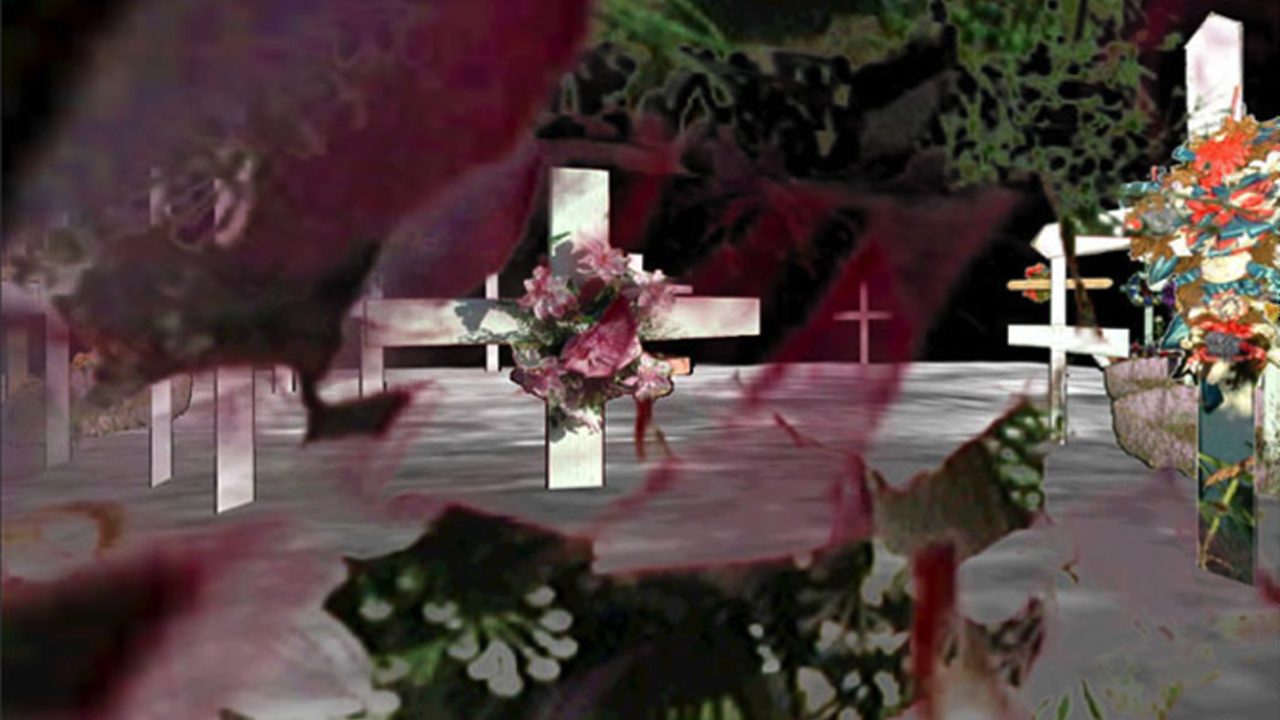Desert Views, Desert Deaths
Developed by Lucy Petrovic and Johnie Hugh Horn
© 2004-2007
August 1st, 2004 - August 1st, 2007

About
“Desert Views, Desert Deaths” is an interactive, immersive, stereoscopic environment using CAVE technology that addresses the U.S./Mexico border enforcement policies.
U.S./Mexico border problems have been escalating in recent years. Strict enforcement of border crossings have forced immigrants away from the main routes and cities they took in the past, to more remote desert locations today. In summer, desert temperatures reach 100-120-degrees Fahrenheit for more than three consecutive months. Illegal “border guides” drop people off in the middle of the desert with one jug of water and tell them that the nearest city is an hour away, when in fact it is often 12 to 18 hours away on foot. A record number of people died of heat stroke or dehydration while crossing the border in 2004. More die every year in the Sonoran Desert.
This virtual unreality is a memorial for those who died while crossing the desert. When users enter “Desert Views, Desert Deaths,” they are in the middle of an elusive graveyard of crosses. In the distance, they can see into translucent overlapping caskets composed of desert images. They enter the life-sized caskets and see the names of those who died of heat and dehydration while crossing the border. As they follow the caskets, they find more information about those who died along the way. While traversing the landscape, the sounds of the desert follow them as they move through their journey. New portals take them to undisclosed locations.
Exhibitions
SIGGRAPH 2007 Art Gallery, Global Eyes, August 2007.
Arizona Biennial, Tucson Museum of Art, May-August 2005. Received Pat Mutterer Award.
ISEA2004, Helsinki, Finland, August 2004. Museum of Estonian Architecture, Tallinn, Estonia.
Hardware and Software Technology
The SIGGRAPH 2007 Art Gallery showing was made possible with the support of Calit2, University of California, San Diego. Special thanks to Tom DeFanti, Jurgen Schulze, Greg Dawe, John Graham, Qian Liu, Joseph Keefe and Kathy Tanaka.
The Tucson Museum and ISEA2004 showings were made possible by University of Arizona’s Fine Arts Technology.
Software donated by VRCO, Inc. Thanks to Matt Szymanski.
About Lucy Petrovic
Lucy Petrovic is a new media artist, educator and researcher working in the digital realm. Her focus has been the exploration of human-computer interactivity, virtual-reality and immersive environments using CAVE technology.
She received her MFA in 1985 from the UIC Electronic Visualization Laboratory (EVL) where her work involved creating digital videos and programming a prototype remote design tool where two people at two different computers could create animations together using references from traditional animation. It was designed to work via modem. This prototype predates the Internet.
She began her professional career as a computer graphics technician at Video Image in Los Angeles, creating graphics for the infamous network television show “Max Headroom” and an esoteric Walt Disney movie entitled “Earth Star Voyager”. She then went on to teach at various universities and colleges, including University of Arizona in Tucson where she began her research in virtual reality. She considers herself fortunate to have worked in Singapore as Dean of Graduate Studies for EggStory Digital Arts School, founded by EggStory Studios, a digital animation and effects studio in Asia. Recently she was hired as Associate Professor at the University of Texas at Dallas.
Throughout the years she has contributed to ISEA, Prix ARS Electronica and extensively to the ACM SIGGRAPH International Computer Graphics Conference. Petrovic’s involvement with SIGGRAPH included Chair of the Exhibition of Computer Art in 1988 and Co-chair of the Electronic Theater in 1994.
Petrovic’s new media work includes creating experimental digital video screened at various festivals, including the Arizona International Film Festival where she won “Best of Arizona.” Her interactive immersive environments have been exhibited internationally, including SIGGRAPH Art Gallery Global Eyes, the Museum of Estonian Architecture with the ISEA Conference, Scottsdale Museum of Contemporary Art, and Tucson Museum of Art.